The great popularity enjoyed by the Gold Ecological Park (黃金博物園區) in New Taipei City’s Jinguashi (金瓜石), which opened in 2004, is proof that Taiwan’s gold fever era continues to exert a strong pull on the public’s imagination.
Countless other long-forgotten miners also risked their lives toiling to dig out a far less romantic, but extremely profitable mineral from beneath the steep, grassy hills of the area. Why else would they call this substance, which we generally call coal, “black gold?”
It seems coal is far less interesting a substance in the minds of the public, and the success of the Houtong Coalmine Ecological Park (猴硐煤礦博物園區), which was created in 2010 around the old village and mining relics of nearby Houtong Village (猴硐) in Ruifang District (瑞芳), has been only moderate, but Houtong still manages to attract large numbers of visitors every weekend. Ninety percent of these come to see its famed “cat village,” a refuge for several hundred stray cats established by animal-loving locals a year or two before the park.
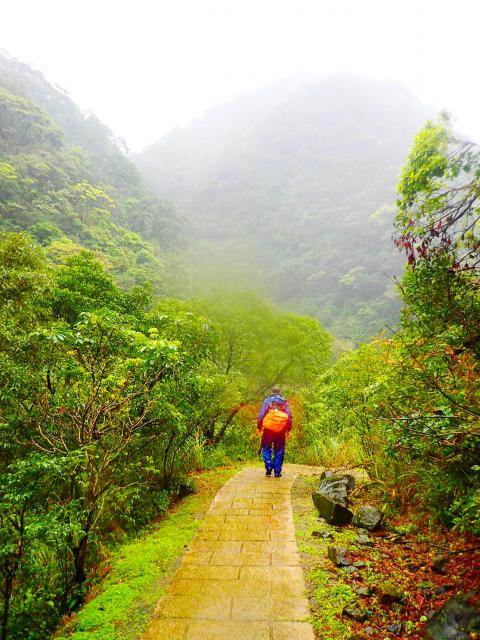
Photo: Richard Saunders
In their heyday, the nearby gold, copper and coal mines supplied work for many: the coal mines of Houtong alone once employed about 6,000 people. With so many workers (plus their families), many were forced to commute in from other villages and settlements in the area.
With the decline of the mining industry, miners began moving out in search of work elsewhere, and by the late 1970s, the old settlements had become ghost towns.
The more conveniently situated villages close to New Taipei City’s Jiufen District (九份), such as the aforementioned Jinguashi and Houtong — the ones connected to the road network — survived until a new source of income came along in the form of tourism. Less fortunate were the twin settlements of Datcukeng (大粗坑) and Siaocukeng (小粗坑), lying high on the ridge dividing Houtong and Jiufen, and well away from any road. Both were abandoned soon after the closure of the last mines, and left, almost forgotten, to be reclaimed by the forest.
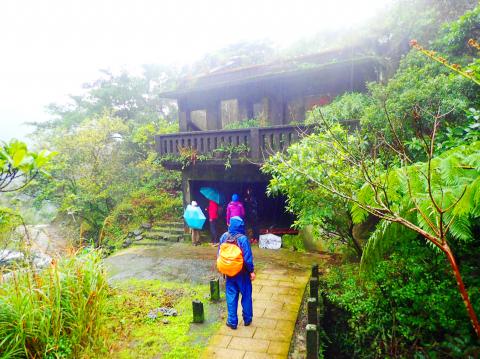
Photo: Richard Saunders
DATCUKENG
The villages can be reached by trails, both starting near Houtong. For Datcukeng, walk out of the village, north along the right bank of the Keelung River, and take a road beside a stream, starting next to Houtong’s former elementary school. Today the school building is a half-abandoned shell, after it was partly destroyed by torrential rains that accompanied Typhoon Xangsane in late October 2000. A huge mudslide swept down the valley, wiping out many houses, killing several residents and severely damaging the school.
Follow the road up beside the stream (which was ducted into a concrete channel following the disaster, to minimize the potential for further mudslides) to the very end, beside which a stone-paved trail continues uphill along the left bank of the cascading stream.
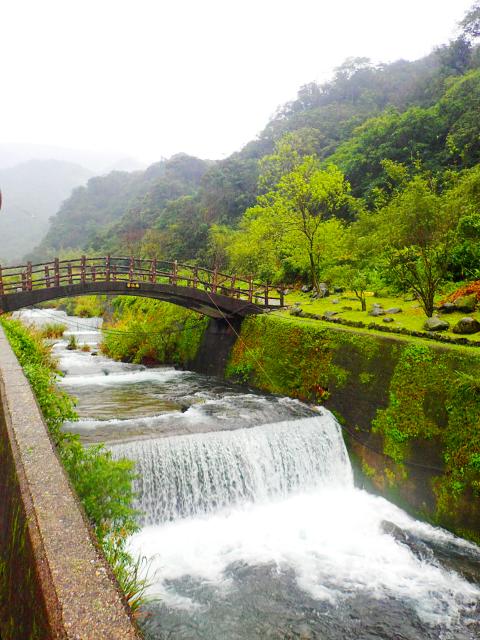
Photo: Richard Saunders
It’s a scenic walk of about 20 minutes to the first houses of the settlement; most have been reclaimed by the thick jungle and are all-but invisible today. It’s hard to believe from the fragmentary remains that can now be seen, but apparently about three hundred families involved in the local mining business once lived here, and it’s said the village had its own elementary school, medical center, shops and even a bar or two.
The village was also the birthplace of Wu Nien-jen (吳念真; born 1952), one of Taiwan’s most famous directors and screenplay writers. He’s perhaps best-known in the West as the scriptwriter for Hou Hsiao-hsien’s (侯孝賢 ) A City of Sadness (悲情城市, 1989), which incidentally was filmed in nearby Jiufen and Jinguashi.
Today a couple of premises beside the main trail are still occupied, but most have already returned to the jungle, are falling into ruin and are all but invisible from the trail. A long and conspicuously out-of-place flight of stone steps, raised on stilts high above the silver grass, climbs the hillside to join a concrete lane, which zigzags up to Provincial Road 102. Turn left and it eventually winds down to Jiufen.
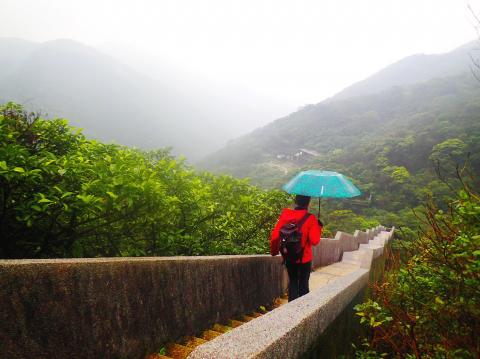
Photo: Richard Saunders
SIAOCUKENG
To get to the second village, Siaocukeng, follow the road beside the Keelung River past the former elementary school and, in a few hundred meters, pass the new school building, erected in a safer location away from the mouth of the valley.
Just after the new school, turn right up a narrow concrete lane beside a signpost and board map, passing the atmospheric remains of a couple of stone-walled houses and an old Earth God Shrine, and crossing two bridges.
The trail begins to climb a long flight of rustic stone steps and soon enters the main area of the former Siaocukeng village. A couple of the stone houses appear to be occupied once more, but the rest of the village has long since been overtaken by the forest. The settlement’s elementary school is now nothing more than a picturesque ruin, and the stumpy former look-out tower is now an inconspicuous shell.
Follow the trail steeply uphill past the last remnants of former miners’ houses, and towards the top of the ridge the trail passes a large Mountain God Shrine (山神廟), built in 1929 for the use of the miners passing through on the way to or from the mines at Jiufen.
Continue uphill, and shortly the trail reaches the top of the ridge, where the woods part to reveal (on a rare clear day in this corner of Taiwan) a magnificent panorama over Jiufen, Keelung Mountain (基隆山) and the Pacific Ocean.
Follow the path down the other side and in 20 minutes or so it joins the road on the edge of Jiufen, at Songde Park (頌德公園). This tiny green space commemorates Yen Yun-nian (顏雲年; 1882 to 1923), the first Taiwanese businessman to persuade the Japanese colonial rulers to sell his (Taiwanese) company rights to mine for gold in the area.
IF YOU GO
Slow trains (and the occasional express) from Taipei Main Station stop at Houtong Station. The trip takes about an hour.
Richard Saunders is a classical pianist and writer who has lived in Taiwan since 1993. He’s the founder of a local hiking group, Taipei Hikers, and is the author of six books about Taiwan, including Taiwan 101 and Taipei Escapes. Visit his Web site at www.taiwanoffthebeatentrack.com.
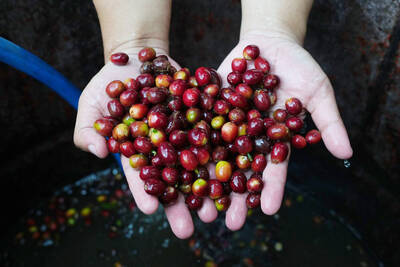
Climate change, political headwinds and diverging market dynamics around the world have pushed coffee prices to fresh records, jacking up the cost of your everyday brew or a barista’s signature macchiato. While the current hot streak may calm down in the coming months, experts and industry insiders expect volatility will remain the watchword, giving little visibility for producers — two-thirds of whom farm parcels of less than one hectare. METEORIC RISE The price of arabica beans listed in New York surged by 90 percent last year, smashing on Dec. 10 a record dating from 1977 — US$3.48 per pound. Robusta prices have
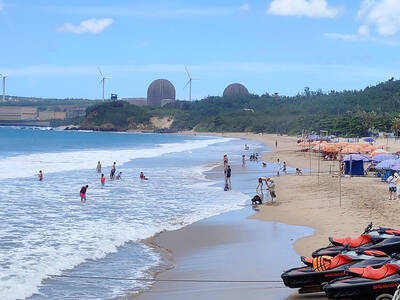
A dozen excited 10-year-olds are bouncing in their chairs. The small classroom’s walls are lined with racks of wetsuits and water equipment, and decorated with posters of turtles. But the students’ eyes are trained on their teacher, Tseng Ching-ming, describing the currents and sea conditions at nearby Banana Bay, where they’ll soon be going. “Today you have one mission: to take off your equipment and float in the water,” he says. Some of the kids grin, nervously. They don’t know it, but the students from Kenting-Eluan elementary school on Taiwan’s southernmost point, are rare among their peers and predecessors. Despite most of
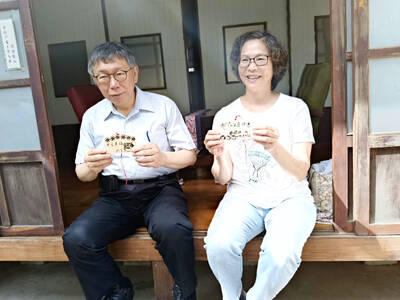
The resignation of Taiwan People’s Party (TPP) co-founder Ko Wen-je (柯文哲) as party chair on Jan. 1 has led to an interesting battle between two leading party figures, Huang Kuo-chang (黃國昌) and Tsai Pi-ru (蔡壁如). For years the party has been a one-man show, but with Ko being held incommunicado while on trial for corruption, the new chair’s leadership could be make or break for the young party. Not only are the two very different in style, their backgrounds are very different. Tsai is a co-founder of the TPP and has been with Ko from the very beginning. Huang has
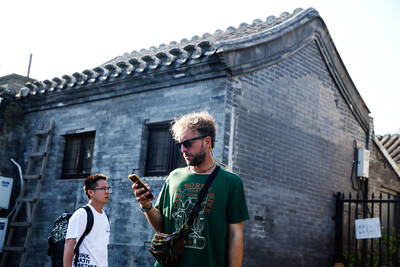
A few years ago, getting a visa to visit China was a “ball ache,” says Kate Murray. The Australian was going for a four-day trade show, but the visa required a formal invitation from the organizers and what felt like “a thousand forms.” “They wanted so many details about your life and personal life,” she tells the Guardian. “The paperwork was bonkers.” But were she to go back again now, Murray could just jump on the plane. Australians are among citizens of almost 40 countries for which China now waives visas for business, tourism or family visits for up to four weeks. It’s